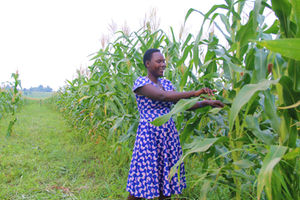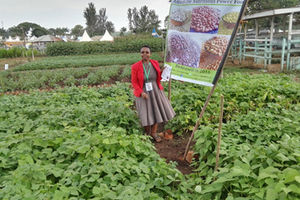
Students learn how plastic bottles can be used to protect soil for vegetable farming at Mbuya Agricultural College. Photo/Micheal J Ssali.
Uganda’s soils are reported to be slowly depreciating yet farmers across the country do not embrace uptake of fertiliser use in their farming system.
The current average rate of fertiliser uptake is estimated to be1.8 to 3 kilogrammes per acre, making Uganda one of the lowest fertiliser users in Africa.
Andrew Byamugisha from Ministry of Agriculture giving the background of fertiliser uptake in the country highlights that the ministry has a department that handles seed, chemicals including fertilisers and pesticides which must be validated by researchers to ensure the right fertiliser is used by farmers for a specific crops.
Fertiliser blends per crop
Grainpulse, an integrated agribusiness company with its fertiliser blending factory located in Mukono is able to blend fertiliser for various crops namely coffee, tobacco, sugarcane, beans, banana, fruit and vegetable among others. The crop specific blends are precisely formulated through a dry, physical mixing process of nitrogen, phosphate and potassium without altering any of their chemical components. These blends are mixed to cater for the exact nutrition needs of a specific crop.
Maize
The recommended quantity is 10kgs, 25kgs, 50kgs to boost the exact proportion as needed by the maize crop for healthy growth and good yield.
The composition is 20 percent nitrogen. 20 percent phosphorus, 18 percent potassium with German fertiliser technology by K+S Kali GmbH.
Farmers are expected to dig a hole, apply five grammes of fertiliser and cover it with some soil to prevent the fertiliser from scorching the seed. Place the maize seed and cover it with soil.
Young coffee blend
The quantity is 10kgs, 25kgs, 50kgs and this blend is tailored specifically for the needs of your coffee trees of two years and below.
It provides good vegetative growth in the young coffee plants, development of a good canopy that supports robust fruit development.
The composition is 19 percent nitrogen, 11 percent phosphorus and 22 percent potassium.
Following the branches of the tree directly proportional to the ground, dig in circular form around the tree and apply 100gms of fertiliser per tree.
Mature coffee blend
Old coffee blend is recommended for trees that are two years and above. Usually, coffee production starts after two years and that is why the nutrient composition of the old coffee blend slightly differs from the young coffee blend.
Old coffee blend is essential for, fruit development and resistance to harsh weather conditions.
Composition: 16 percent nitrogen, two percent phosphorus and 31 percent potassium. And application is same as the young seedling but apply 200gms per hole.
Beans, groundnuts
This blend has the specific nutrients, in the right amounts needed for beans, groundnuts and soybeans balanced nutrition, health and growth and to give high yields, resistance to disease and drought.
Composition: 11 percent nitrogen, 29 percent phosphorus, 23 percent potassium and apply five grammes of fertiliser in a hole and cover it with some soil, then place the seed.
Banana, pineapple and ginger
Bananas, ginger and pineapple plants all have the same nutrition needs. They all require nitrogen, phosphorus and potassium in the right amounts for their growth and survival.
Composition: 19 percent nitrogen, eight percent phosphorus, 28 percent potassium and farmers must apply 100grammes per plantlet.
Tomatoes, onions, eggplants
Tomatoes, onions, eggplants, cabbages and lettuce are heavy feeders of nitrogen, phosphorus and potassium. The fertiliser blend helps to provide nutritional balance and helps to protect the plant from effects caused by temperatures.
Composition: 24 percent nitrogen, 16 percent phosphorus, 14 percent potassium and farmer must dig a hole and pour five grammes of fertiliser per hole.
Crop: sorghum, rice, barley and finger millet
Seeds are living things and they need to be well fed, with a fertiliser that has balanced nutrition needs required for their health and proper growth.
It increases volume and quality of crops, enhances resistance to stress and improves dry matter content producing heavier grains.
Composition: 23 percent Nitrogen, 17 percent Phosphorus, 12 percentPotassium +3S+2Mg and each seed requires five grammes, however, for easy application, make a ridge, apply fertiliser in that estimated amount.
Cassava, sweet potato
Its exclusive and well balanced nutrient composition makes it the best fertiliser for both cassava and sweet potatoes. It is responsible for, improved tuber quality
Urea
Urea is a major source of nitrogen, since it has a very high nitrogen content promoting green leafy growth. The blending composition has 46 percent nitrogen and helps in photosynthesis process.




